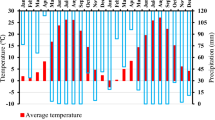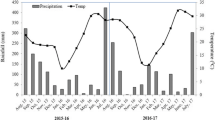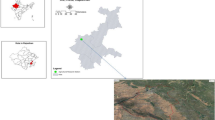Abstract
Purpose
Conservation tillage systems, including no-till and minimum-till, benefit soil quality and soil water preservation as well as reduce the economic and energetic costs of agricultural production. Nonetheless, specific knowledge regarding the interactions between conservation tillage and other crop management practices targeting improved system sustainability on crop yield and quality as well as nitrogen dynamics and losses remain understudied in drought impacted, arid and semi-arid environments and sandy soils. This study investigated the effects of different tillage systems (no-tillage, minimum and conventional), fertilizers (no fertilizer, vermicompost, urea and combined urea and vermicompost (VU) and irrigation regimes (normal irrigation and irrigation after 50% field capacity) on various quantitative and qualitative traits of rapeseed as well as soil nitrate leaching (NL).
Methods
Field trials were conducted between two growing seasons (2017–2018 and 2018–2019) in Karaj, Iran. The experimental design was a randomized complete block with the arrangement split-split-plot and three replications. Tillage system was assigned to the main plot meanwhile, irrigation was considered as the sub-plot and fertilizer was considered as sub-sub-plot.
Results
Under both the deficit and normal irrigation regimes and across all tillage types, the highest seed yield, oil yield and nitrogen use efficiency (NUE) were found where VU treatment was applied. Furthermore, across all tillage types, the highest NL was observed where urea was applied. When compared with urea, vermicompost and UV treatments respectively decreased the NL by 67 and 50% in no-till plots, 50 and 36% in minimum till plots and 49 and 34% in conventional till plots. Consistent with this, the lowest mean NL (10.4 kg ha−1) resulted from plots where the water-deficit condition was combined with no fertilizer meanwhile, the highest mean NL (83.1 kg ha−1) resulted where normal irrigation was combined with urea.
Conclusion
The findings indicate that minimum till in combination with VU treatments support reduced NL over conventional till and urea fertilization practices while improving rapeseed quantitative and qualitative traits.



Similar content being viewed by others
References
Adrian PB, Priya OV, Chip A (2016) Nitrogen dynamics of Vermicompost use in sustainable agriculture. J Soil Sci Environ Manag 7:173–183. https://doi.org/10.5897/JSSEM2016.0587
Agbede TM (2010) Tillage and fertilizer effects on some soil properties, leaf nutrient concentrations, growth and sweet potato yield on an Alfisol in southwestern Nigeria. Soil Tillage Res 110:25–32. https://doi.org/10.1016/j.still.2010.06.003
Al Jaouni S, Selim S, Hassan SH et al (2019) Vermicompost supply modifies chemical composition and improves nutritive and medicinal properties of date palm fruits from Saudi Arabia. Front Plant Sci 10:1–13. https://doi.org/10.3389/fpls.2019.00424
Alam MK, Islam MM, Salahin N, Hasanuzzaman M (2014) Effect of tillage practices on soil properties and crop productivity in wheat-Mungbean-Rice cropping system under subtropical climatic conditions. Sci World J 2014:1–15. https://doi.org/10.1155/2014/437283
Allen RG, Pereira LS, Raes D, Smith M (1998) Crop evapotraspiration guidelines for computing crop water requirements
Álvaro-Fuentes J, Morell FJ, Madejón E et al (2013) Soil biochemical properties in a semiarid Mediterranean agroecosystem as affected by long-term tillage and N fertilization. Soil Tillage Res 129:69–74. https://doi.org/10.1016/j.still.2013.01.005
Arif M, Ali K, Jan MT et al (2016) Integration of biochar with animal manure and nitrogen for improving maize yields and soil properties in calcareous semi-arid agroecosystems. F Crop Res 195:28–35. https://doi.org/10.1016/j.fcr.2016.05.011
Aslam MN, Nelson MN, Kailis SG et al (2009) Canola oil increases in polyunsaturated fatty acids and decreases in oleic acid in drought-stressed Mediterranean-type environments. Plant Breed 128:348–355. https://doi.org/10.1111/j.1439-0523.2008.01577.x
Asperger A, Engewald W, Fabian G (2001) Thermally assisted hydrolysis and methylation - a simple and rapid online derivatization method for the gas chromatographic analysis of natural waxes. J Anal Appl Pyrolysis 61:91–109. https://doi.org/10.1016/S0165-2370(01)00116-4
Baldini M, Giovanardi R, Tahmasebi enferadi S, Vannozzi GP (2002) Effects of water regime on fatty acid accumulation and final fatty acid composition in the oil of standard and high oleic sunflower hybrids. Ital J Agron 6:119–126
Bates PD, Stymne S, Ohlrogge J (2013) Biochemical pathways in seed oil synthesis. Curr Opin Plant Biol 16:358–364. https://doi.org/10.1016/j.pbi.2013.02.015
Behera SK, Panda RK (2009) Effect of fertilization and irrigation schedule on water and fertilizer solute transport for wheat crop in a sub-humid sub-tropical region. Agric Ecosyst Environ 130:141–155. https://doi.org/10.1016/j.agee.2008.12.009
Beljkaš B, Matić J, Milovanović I et al (2010) Rapid method for determination of protein content in cereals and oilseeds: validation, measurement uncertainty and comparison with the Kjeldahl method. Accred Qual Assur 15:555–561. https://doi.org/10.1007/s00769-010-0677-6
Bergstrom L, Johansson R (1991) Leaching of nitrate from monolith lysimeters of different types of agricultural soils. J Environ Qual 20:801–807. https://doi.org/10.2134/jeq1991.00472425002000040015x
Biondo PBF, Dos Santos VJ, Montanher PF et al (2015) A new method for lipid extraction using low-toxicity solvents developed for canola (Brassica napus L.) and soybean (Glycine max L. Merrill) seeds. Anal Methods 7:9773–9778. https://doi.org/10.1039/c5ay02243f
Boveiri Dehsheikh A, Mahmoodi Sourestani M, Zolfaghari M, Enayatizamir N (2020) Changes in soil microbial activity, essential oil quantity, and quality of Thai basil as response to biofertilizers and humic acid. J Clean Prod 256:120439. https://doi.org/10.1016/j.jclepro.2020.120439
Chaturvedi AK, Surendran U, Gopinath G et al (2019) Elucidation of stage specific physiological sensitivity of okra to drought stress through leaf gas exchange, spectral indices, growth and yield parameters. Agric Water Manag 222:92–104. https://doi.org/10.1016/j.agwat.2019.05.041
Chen Y min, Zhang J yuan, Xu X, et al (2018) Effects of different irrigation and fertilization practices on nitrogen leaching in facility vegetable production in northeastern China. Agric Water Manag 210:165–170. doi: https://doi.org/10.1016/j.agwat.2018.07.043
Demir Z (2019) Effects of Vermicompost on soil physicochemical properties and lettuce (Lactuca sativa Var. Crispa) yield in greenhouse under different soil water regimes. Commun Soil Sci Plant Anal 50:2151–2168. https://doi.org/10.1080/00103624.2019.1654508
Demir Z (2020) Alleviation of adverse effects of sodium on soil physicochemical properties by application of Vermicompost. Compost Sci Util 0:1–17. doi: https://doi.org/10.1080/1065657X.2020.1789011
Dijkstra FA, Cheng W (2008) Increased soil moisture content increases plant N uptake and the abundance of 15N in plant biomass. Plant Soil 302:263–271 https://doi.org/10.1007/s11104-007-9477-0
Dimkpa CO, Andrews J, Sanabria J et al (2020) Interactive effects of drought, organic fertilizer, and zinc oxide nanoscale and bulk particles on wheat performance and grain nutrient accumulation. Sci Total Environ 722:137808 https://doi.org/10.1016/j.scitotenv.2020.137808
Domínguez J, Aira M, Kolbe AR et al (2019) Changes in the composition and function of bacterial communities during vermicomposting may explain beneficial properties of vermicompost. Sci Rep 9:1–11 https://doi.org/10.1038/s41598-019-46018-w
Doorenbos J, Kassam A. (1979) Yield response to water. FAO irrigation and drainage paper 33, Rome
Errebhi M, Rosen CJ, Gupta SC, Birong DE (1998) Potato yield response and nitrate leaching as influenced by nitrogen management. Agron J 90:10–15 https://doi.org/10.2134/agronj1998.00021962009000010003x
FAO (2019) Oilcrops. FAO 53:1689–1699
Feizabadi A, Noormohammadi G, Fatehi F (2021) Changes in growth, physiology, and fatty acid profile of rapeseed cultivars treated with Vermicompost under drought stress. J Soil Sci Plant Nutr 21:200–208 https://doi.org/10.1007/s42729-020-00353-4
Fu Q, Abadie M, Blaud A et al (2020) Effects of urease and nitrification inhibitors on soil N, nitrifier abundance and activity in a sandy loam soil. Biol Fertil Soils 56:185–194 https://doi.org/10.1007/s00374-019-01411-5
Gaines TP, Gaines ST (1994) Soil texture effect on nitrate leaching in soil percolates. Commun Soil Sci Plant Anal 25:2561–2570 https://doi.org/10.1080/00103629409369207
Githinji HK, Okalebo JR, Othieno CO et al (2011) Innovations as key to the green revolution in Africa. Innovations as Key to the Green Revolution in Africa, In
Gómez-Rey MX, Couto-Vázquez A, González-Prieto SJ (2012) Nitrogen transformation rates and nutrient availability under conventional plough and conservation tillage. Soil Tillage Res 124:144–152 https://doi.org/10.1016/j.still.2012.05.010
Gómez-Rubio V (2017) ggplot2 - elegant graphics for data analysis (2nd edition). J Stat Softw 77:3–5 https://doi.org/10.18637/jss.v077.b02
Gotosa J, Kodzwa J, Gwenzi W, Nyamangara J (2020) Maize nitrogen uptake and productivity under reduced and conventional tillage. Nutr Cycl Agroecosystems 7: https://doi.org/10.1007/s10705-020-10104-7
Hosseinzadeh MH, Ghalavand A, Boojar MMA et al (2021) Application of manure and biofertilizer to improve soil properties and increase grain yield, essential oil and ω3 of purslane (Portulaca oleracea L.) under drought stress. Soil Tillage Res 205:104633 https://doi.org/10.1016/J.STILL.2020.104633
Itoh A, Schilmiller AL, McCaig BC, Howe GA (2002) Identification of a jasmonate-regulated allene oxide synthase that metabolizes 9-hydroperoxides of linoleic and linolenic acids. J Biol Chem 277:46051–46058 https://doi.org/10.1074/jbc.M207234200
Khodabin G, Tahmasebi-Sarvestani Z, Rad AHS et al (2021) Effect of late-season drought stress and foliar application of ZnSO4 and MnSO4 on the yield and some oil characteristics of rapeseed cultivars. J Soil Sci Plant Nutr 21:1904–1916 https://doi.org/10.1007/s42729-021-00489-x
Leleu O, Vuylsteker C, Têtu JF, et al (2000) Effect of two contrasted N fertilisations on rapeseed growth and nitrate metabolism. Plant Physiol Biochem 38:639–645. https://doi.org/10.1016/S0981-9428(00)00784-1
Li X, Hu C, Delgado JA et al (2007) Increased nitrogen use efficiencies as a key mitigation alternative to reduce nitrate leaching in North China plain. Agric Water Manag 89:137–147 https://doi.org/10.1016/j.agwat.2006.12.012
Li Y, Li Z, Cui S et al (2019) Residue retention and minimum tillage improve physical environment of the soil in croplands: a global meta-analysis. Soil Tillage Res 194:104292 https://doi.org/10.1016/j.still.2019.06.009
Liu S, Lv Z, Liu Y et al (2018) Network analysis of ABA-dependent and ABA-independent drought responsive genes in Arabidopsis thaliana. Genet Mol Biol 41:624–637 https://doi.org/10.1590/1678-4685-gmb-2017-0229
Liu M, Wang C, Wang F, Xie Y (2019) Maize (Zea mays) growth and nutrient uptake following integrated improvement of vermicompost and humic acid fertilizer on coastal saline soil. Appl Soil Ecol 142:147–154 https://doi.org/10.1016/j.apsoil.2019.04.024
Lu C, Tian H (2017) Global nitrogen and phosphorus fertilizer use for agriculture production in the past half century: shifted hot spots and nutrient imbalance. Earth Syst Sci Data 9:181–192 https://doi.org/10.5194/essd-9-181-2017
Luo Z, Kong X, Zhang Y et al (2019) Leaf-derived jasmonate mediates water uptake from hydrated cotton roots under partial root-zone irrigation. Plant Physiol 180:1660–1676 https://doi.org/10.1104/pp.19.00315
Mendiburu F de (2019) Statistical pocedures for agricultural research-package “agricolae”
Moradi Aghdam A, Sayfzadeh S, Shirani Rad AH et al (2019) The assessment of water stress and delay cropping on quantitative and qualitative traits of rdoi: apeseed genotypes. Ind Crop Prod 131:160–165 https://doi.org/10.1016/j.indcrop.2019.01.051
Nazeri P, Rad AHS, ValadAbadi SA et al (2018) Effect of sowing dates and late season water deficit stress on quantitative and qualitative traits of canola cultivars. Outlook Agric 47:291–297 https://doi.org/10.1177/0030727018793658
Niu Y, Luo J, Liu D et al (2018) Effect of biochar and nitrapyrin on nitrous oxide and nitric oxide emissions from a sandy loam soil cropped to maize. Biol Fertil Soils 54:645–658 https://doi.org/10.1007/s00374-018-1289-2
Nunes MR, Karlen DL, Veum KS et al (2020) Biological soil health indicators respond to tillage intensity: a US meta-analysis. Geoderma 369:114335 https://doi.org/10.1016/j.geoderma.2020.114335
Obia A, Cornelissen G, Martinsen V et al (2020) Conservation tillage and biochar improve soil water content and moderate soil temperature in a tropical Acrisol. Soil Tillage Res 197:104521 https://doi.org/10.1016/j.still.2019.104521
Ohlrogge J, Browse J (1995) Lipid biosynthesis. Plant Cell 7:957–970 https://doi.org/10.1105/tpc.7.7.957
Orlovius K (2016) Fertilizing for high yield and quality: oilseed rape. IPI bull 1–19
Rathke GW, Behrens T, Diepenbrock W (2006) Integrated nitrogen management strategies to improve seed yield, oil content and nitrogen efficiency of winter oilseed rape (Brassica napus L.): a review. Agric Ecosyst Environ 117:80–108 https://doi.org/10.1016/j.agee.2006.04.006
Riemann M, Dhakarey R, Hazman M et al (2015) Exploring jasmonates in the hormonal network of drought and salinity responses. Front Plant Sci 6:1–16 https://doi.org/10.3389/fpls.2015.01077
Rosa L, Chiarelli DD, Rulli MC et al (2020) Global agricultural economic water scarcity. Sci Adv 6:1–11 https://doi.org/10.1126/sciadv.aaz6031
Shepherd M, Newell-Price P (2013) Manure management practices applied to a seven-course rotation on a sandy soil: effects on nitrate leaching. Soil Use Manag 29:210–219 https://doi.org/10.1111/sum.12024
Six J, Elliott ET, Paustian K (2000) Soil macroaggregate turnover and microaggregate formation: a mechanism for C sequestration under no-tillage agriculture. Soil Biol Biochem 32:2099–2103. https://doi.org/10.1016/S0038-0717(00)00179-6
Spiess E, Humphrys C, Richner W et al (2020) Does no-tillage decrease nitrate leaching compared to ploughing under a long-term crop rotation in Switzerland? Soil Tillage Res 199:104590 https://doi.org/10.1016/j.still.2020.104590
Sun XP, Yan HL, Kang XY, Ma FW (2013) Growth, gas exchange, and water-use efficiency response of two young apple cultivars to drought stress in two scion-one rootstock grafting system. Photosynthetica 51:404–410 https://doi.org/10.1007/s11099-013-0040-3
Syswerda SP, Basso B, Hamilton SK et al (2012) Long-term nitrate loss along an agricultural intensity gradient in the upper Midwest USA. Agric Ecosyst Environ 149:10–19 https://doi.org/10.1016/j.agee.2011.12.007
Te Chow V, Maidment DR, Mays LW (1988) Applied hydrology. McGraw-Hill, New York
Thines B, Katsir L, Melotto M et al (2007) JAZ repressor proteins are targets of the SCFCOI1 complex during jasmonate signalling. Nature 448:661–665 https://doi.org/10.1038/nature05960
Ullah H, Santiago-Arenas R, Ferdous Z et al (2019) Improving water use efficiency, nitrogen use efficiency, and radiation use efficiency in field crops under drought stress: a review, 1st edn. Elsevier Inc.
Vázquez N, Pardo A, Suso ML, Quemada M (2005) A methodology for measuring drainage and nitrate leaching in unevenly irrigated vegetable crops. Plant Soil 269:297doi: −308. https://doi.org/10.1007/s11104-004-0630-8
Victoria G, Jean-louis D, François G (2010) Review article Water deficit and nitrogen nutrition of crops . A review. Agron Sustain Dev 30:529–544
Vrablik TL, Watts JL (2012) Emerging roles for specific fatty acids in developmental processes. Genes Dev 26:631–637. https://doi.org/10.1101/gad.190777.112
Wang H, Guo Z, Shi Y et al (2015) Impact of tillage practices on nitrogen accumulation and translocation in wheat and soil nitrate-nitrogen leaching in drylands. Soil Tillage Res 153:20–27. https://doi.org/10.1016/j.still.2015.03.006
Wang H, Liu J, Xu X et al (2016) Fully-automated high-throughput NMR system for screening of haploid kernels of maize (corn) by measurement of oil content. PLoS One 11:1–14. https://doi.org/10.1371/journal.pone.0159444
Wang H, Wu L, Cheng M et al (2018) Coupling effects of water and fertilizer on yield, water and fertilizer use efficiency of drip-fertigated cotton in northern Xinjiang, China. F Crop Res 219:169–179. https://doi.org/10.1016/j.fcr.2018.02.002
Wang Y, Zhang X, Chen J et al (2019) Reducing basal nitrogen rate to improve maize seedling growth, water and nitrogen use efficiencies under drought stress by optimizing root morphology and distribution. Agric Water Manag 212:328–337. https://doi.org/10.1016/j.agwat.2018.09.010
Zheng J, Qu Y, Kilasara MM et al (2019) Nitrate leaching from the critical root zone of maize in two tropical highlands of Tanzania: effects of fertilizer-nitrogen rate and straw incorporation. Soil Tillage Res 194:104295. https://doi.org/10.1016/j.still.2019.104295
Zucco MA, Walters SA, Chong SK et al (2015) Effect of soil type and vermicompost applications on tomato growth. Int J Recycl Org Waste Agric 4:135–141. https://doi.org/10.1007/s40093-015-0093-3
Acknowledgements
We would like to appreciation Tarbiat Modares University, Seed and Plant Improvement Institute (SPII) and Alborz Research Station for providing funding and letting us to use their field and laboratory equipments. We would also like to express our very great appreciation to Mrs. Cheraghalizadeh and Moazeni for providing tillage instruments.
Funding
This work was financially supported by the Tarbiat Modares University and Alborz Research Station, Research Institute of Forests and Rangelands (RIFR) [Grant number: R-9563:164].
Author information
Authors and Affiliations
Corresponding authors
Additional information
Responsible Editor: Dorte Bodin Dresbøll
Publisher’s note
Springer Nature remains neutral with regard to jurisdictional claims in published maps and institutional affiliations.
Rights and permissions
About this article
Cite this article
Khodabin, G., Lightburn, K., Hashemi, S.M. et al. Evaluation of nitrate leaching, fatty acids, physiological traits and yield of rapeseed (Brassica napus) in response to tillage, irrigation and fertilizer management. Plant Soil 473, 423–440 (2022). https://doi.org/10.1007/s11104-021-05294-0
Received:
Accepted:
Published:
Issue Date:
DOI: https://doi.org/10.1007/s11104-021-05294-0




